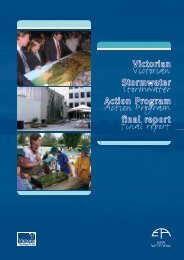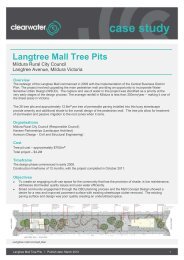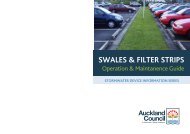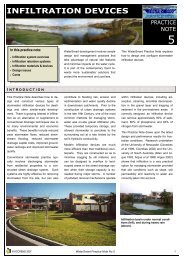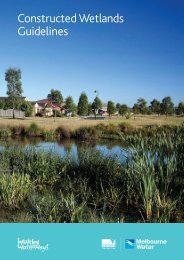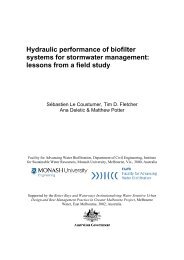CRC Street Sweep Eval 1999.pdf( 489.9 KB ) - Clearwater
CRC Street Sweep Eval 1999.pdf( 489.9 KB ) - Clearwater
CRC Street Sweep Eval 1999.pdf( 489.9 KB ) - Clearwater
You also want an ePaper? Increase the reach of your titles
YUMPU automatically turns print PDFs into web optimized ePapers that Google loves.
COOPERATIVE RESEARCH CENTRE FOR CATCHMENT HYDROLOGY<br />
1 Introduction<br />
This report presents the findings of an investigation<br />
on the effectiveness of current Australian street<br />
sweeping practices in the collection of pollutants<br />
across the typical range of particle sizes found on<br />
street surfaces. The study was initiated to define and<br />
scope a further more-detailed field-based study to<br />
quantify the effectiveness of current street sweeping<br />
practices as an at-source stormwater pollution<br />
management measure. The term street sweeping is<br />
used here to describe essentially the operation of large<br />
trucks to remove deposited litter and debris from the<br />
kerb and channel of major roadways, streets, and<br />
carparks. The study examines the effectiveness of<br />
street sweeping practices to remove pollutants of two<br />
types:- (i) gross pollutant and litter removal and (ii)<br />
sediment and associated contaminant removal.<br />
Over the past decade there has been an increase in the<br />
management of urban stormwater to protect urban<br />
waterways and receiving waters. These initiatives<br />
have, in part, resulted from community awareness of<br />
environmental impacts of urban stormwater pollution<br />
and their expectation that urban aquatic ecosystems<br />
should be protected from further environmental<br />
degradation.<br />
Pollutants generated from urban land-use activities<br />
are transported by stormwater to urban receiving<br />
waters. Pollutants washed off street surfaces include<br />
gross pollutants, sediment and associated metals,<br />
nutrients, hydrocarbons and dissolved pollutants.<br />
Increased volumes of stormwater runoff and<br />
discharge rates resulting from increased impervious<br />
surface areas and hydraulically efficient drainage<br />
infrastructure throughout urban catchments have<br />
meant that the transport of urban pollutants to<br />
receiving waters is particularly efficient.<br />
Most urban metropolitan councils perform cleansing<br />
of streets and similar impervious surfaces. This is<br />
commonly for the purpose of controlling gross<br />
pollutants, particularly litter, to maintain a level of<br />
street cleanliness and aesthetic quality. The focus on<br />
environmental issues is growing and local authorities<br />
are now considering street sweeping as a beneficial<br />
at-source method for reducing the amount of street<br />
borne pollutants entering the stormwater system. The<br />
actual contribution of street sweeping to the<br />
abatement of stormwater pollution is however not<br />
well understood. The objectives of street sweeping<br />
for street aesthetics and stormwater pollution control<br />
are very different, with the former placing particular<br />
emphasis on the visual impact of environmental<br />
pollution while the latter encompasses a much wider<br />
range of pollutant types and sizes. Despite street<br />
sweeping being widely considered an at-source<br />
stormwater pollution control method its effectiveness<br />
is unknown.<br />
This report undertakes an interpretation of relevant<br />
street sweeping literature, research and survey results.<br />
The background to street sweeping operations,<br />
focusing on the effectiveness of sweeping for removal<br />
of street surface pollutants, is established in Section 2.<br />
The methodology undertaken for this investigation is<br />
discussed in Section 3. Results from a survey of 21<br />
Melbourne Metropolitan councils on street sweeping<br />
practices are assessed in Section 4, to establish an<br />
understanding of current operations, target pollutants<br />
and sweeping frequencies. The different types of<br />
street sweeping mechanisms and their measured<br />
effectiveness are examined in Section 5. Pollutant<br />
types found on street surfaces are reviewed in Section<br />
6, including an analysis of Australian sediment<br />
characteristics to assess the influence of street<br />
sweeping practices on fine particulates and associated<br />
contaminants.<br />
Inter-event dry periods can influence street sweeping<br />
effectiveness and these are determined using<br />
Australian rainfall statistics in Section 7, and<br />
compared with current sweeping frequency and<br />
timing information. Section 8 examines field data to<br />
determine gross pollutant load generation and the<br />
influence of catchment land-use and associated<br />
sweeping frequency on pollutant load. The impact<br />
street sweeping has on gross pollutant loads entering<br />
the stormwater drainage system is discussed in<br />
Section 9, highlighting important issues affecting<br />
current sweeping efficiencies. Section 10 concludes<br />
with a summary of specific observations from each of<br />
the sections of the report from which the effectiveness<br />
of street sweeping as a stormwater pollution control<br />
method is assessed.<br />
1




